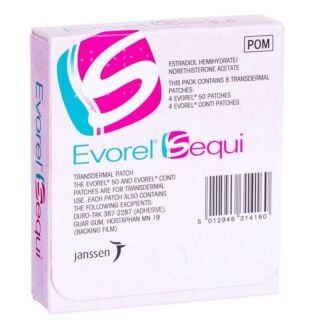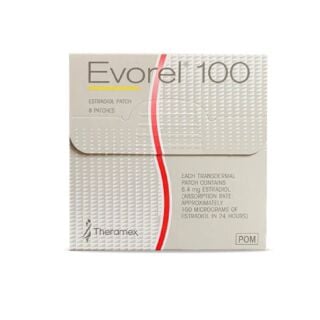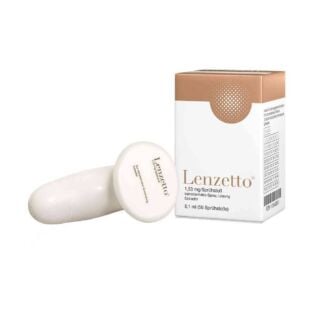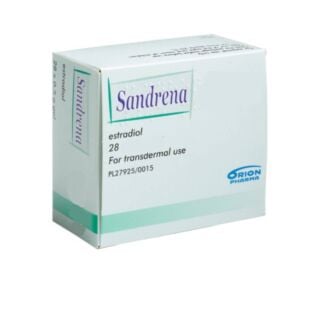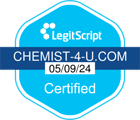Everything you need to know about hormone replacement therapy (HRT)

If you’re going through the menopause, you’ve probably considered hormone replacement therapy (HRT)[1] at some point to help manage your symptoms.
It’s one of the most widely used medications to treat menopausal symptoms in women, ranging from hot flashes and sleep sweats to vaginal dryness and mood swings.
But like all medications, it isn’t suitable for everybody, and you may need to weigh up the potential risks alongside the benefits. There are different types of HRT, too, like tablets, patches, gels, creams, sprays, vaginal rings and pessaries.
The type of HRT you may be offered can depend on multiple things, for example, if you've had a hysterectomy, what stage of menopause you're at and your personal preferences.
Navigating the world of HRT can be both daunting and confusing. Thankfully, we’re here to simplify it for you. Keep reading to discover everything you need to know about HRT to help you make an informed choice whether it’s the right option for you.
What is hormone replacement therapy (HRT)?
Hormone replacement therapy (HRT) involves taking hormones, like oestrogen and progesteron, to replace what the body isn't making enough of anymore.
During the menopause, these two hormone levels deplete, which causes a range of uncomfortable symptoms like hot flashes and night sweats.
Oestrogen and progesteron play vital roles in regulating your menstrual cycles, supporting ovulation and sustaining a healthy pregnancy. Additionally, these hormones are crucial for maintaining strong and healthy bones.
However, as you age, the decline in these hormones can significantly impact your body. HRT aims to relieve this discomfort, so you can feel more like yourself while you go through the change.
Who can’t take HRT
Hormone replacement therapy (HRT) is generally a suitable option if you're experiencing menopausal symptoms. However, HRT may not be the right choice for you if:
- You have a history of breast cancer, ovarian cancer or womb cancer
- You have a history of blood clots; in such cases, patches or gels may be recommended instead of tablets
- You have untreated high blood pressure, and your blood pressure needs to be controlled before starting HRT
- You have liver disease
- You are pregnant. It's important to use contraception if you're under 50 until 2 years after your last period or for 1 year after the age of 50, as it's still possible to get pregnant while on HRT
If any of these situations apply to you, your healthcare provider may suggest alternatives to HRT.
The benefits of HRT
Not only can HRT make daily life more manageable by easing menopausal symptoms like hot flashes and night sweats, but it can also improve vaginal health, alleviating dryness and discomfort, which can enhance sexual well-being and reduce the risk of infections.
Mood swings and emotional disturbances common during menopause can be stabilised with HRT, leading to improved mental health.
Additionally, HRT can help to maintain bone density, reducing the risk of osteoporosis [2], and in some cases, it may positively impact heart health by improving cholesterol levels.
The risks of HRT
HRT carries potential risks that should be carefully considered. These risks can vary based on factors like the type of HRT, dosage and your personal health.
The medicine may slightly increase the risk of breast cancer, especially with long-term use, and the risk of endometrial cancer when oestrogen is used without progesteron in women with an intact uterus.
Blood clots, potentially leading to conditions like deep vein thrombosis and pulmonary embolism, is another concern. There's also a slight increase in the risk of stroke and heart disease, particularly in older women or those with existing cardiovascular risk factors.
HRT can elevate the risk of gallbladder disease and may cause unexpected vaginal bleeding in some cases.
Potential side effects
HRT may cause side effects, although not everyone will experience them. If you’re concerned about any of the potential side effects listed below, you should speak to your healthcare provider for advice.
Common side effects of HRT include:
- Breast tenderness
- Headaches
- Bloating
- Fluid retention
- Irregular or unexpected vaginal bleeding
- Nausea
- Mood swings
- Indigestion
- Changes in bowel habits
- Skin changes such as acne or skin sensitivity
- Weight gain
Signs that you may need to start HRT
If you're experiencing signs and symptoms of hormonal imbalances associated with menopause, HRT is something to consider.
You might be having troublesome hot flashes and night sweats that disrupt your daily life, vaginal dryness or discomfort during sexual activity, mood swings, irritability and depression that significantly impacts your well-being, and concerns about bone health and osteoporosis.
Sleep disturbances, irregular menstrual cycles, decreased libido and cognitive issues can also be reasons to consider HRT.
However, the decision to start HRT should be made in consultation with a healthcare provider who can assess your symptoms, overall health and medical history and help you weigh the potential risks and benefits before beginning treatment.
How long do you take HRT for?
There's no strict time limit on how long you can continue taking HRT. Typically, an annual review of your treatment is recommended.
The duration of HRT use can vary based on individual factors. For symptoms like hot flushes, HRT is often needed for 2 to 5 years, although some women may require it for a longer period. The decision to continue HRT should be based on a balance between its benefits and risks, taking into account your specific symptoms, age and any risk factors you may have.
It's important to note that vaginal oestrogen, used for vaginal dryness, carries fewer risks than other forms of HRT, so it can be continued for as long as needed to manage the condition.

Stopping HRT
If you're considering stopping HRT, you should have a discussion with your GP beforehand. If you're over 50 and using HRT to alleviate menopausal symptoms, your GP may recommend attempting to stop HRT every 2 to 3 years to assess whether it's still necessary or if your symptoms have improved.
Should your menopause symptoms come back once you’ve stopped, and you determine that the benefits of HRT continue to outweigh the risks, you have the option to extend the use of HRT for a longer duration.
The different types of HRT
Combined HRT
This type of HRT contains both oestrogen and progestogen. It’s typically prescribed for women who still have their uterus (womb) because taking oestrogen alone can increase the risk of endometrial cancer. Combined HRT helps protect the uterine lining and reduces this risk.
Sequential combined HRT
If you're experiencing menopause symptoms but still have periods, your healthcare provider may suggest sequential (cyclical) combined HRT [3], which is available in tablet or patch form. There are two variations.
Monthly HRT: If you're still having regular periods, you take oestrogen daily and combine it with progestogen for the last 10 to 14 days of your monthly menstrual cycle.
3-Monthly HRT: If your periods are irregular, you take oestrogen daily and use progestogen for about 10 to 14 days every three months.
It's expected that you'll have a period at the end of each progestogen cycle. If there's no bleeding during these times, it's essential to consult your doctor.
If you began sequential HRT during perimenopause [4], your doctor may recommend transitioning to continuous combined HRT post-menopause [5].
Continuous combined HRT
Continuous combined HRT [6] is usually recommended if you're post-menopause. This is when you have not had a period for 1 year. Continuous combined HRT involves taking oestrogen and progestogen every day without a break.
Oestrogen-only HRT
This type of HRT contains oestrogen alone and is primarily prescribed for women who have had a hysterectomy (surgical removal of the uterus). Since there is no uterus, there is no risk of endometrial cancer, so progestogen is not necessary.
Ways you can take HRT
Tablets
Tablets are a widely used form of HRT, typically taken once a day. They come in both oestrogen-only and combined HRT varieties.
One of the main advantages of taking tablets is the convenience. Taking a daily tablet is a straightforward and simple way to receive treatment.
But it's important to note that certain risks associated with HRT, like the potential for blood clots, are slightly higher when using tablets compared to patches, gels or sprays, although the overall risk remains relatively small.
Patches
Skin patches are another popular type of HRT. These patches adhere to the lower part of your body's skin, and they steadily release small quantities of hormones into your system.
The amount of times you’ll need to change your patch varies between brands, typically requiring a change every few days. Both oestrogen-only and combined HRT options can be found in the form of skin patches.
They’re a good option if you don’t want to commit to taking a tablet each day, or you have difficulty swallowing tablets. By using HRT patches, you potentially avoid certain side effects like indigestion. Unlike tablets, patches typically do not elevate the risk of blood clots either.
However, some individuals may struggle with the patches not adhering securely, particularly if their skin is moisturised. Patches may occasionally lead to redness, irritation or leave marks on the skin.
To prevent these issues, applying the patch to dry, non-moisturised skin or removing it slowly to prevent marks is advisable.

Oestrogen gel
Oestrogen gel is applied by smoothing it onto your skin once a day, allowing the gradual absorption of oestrogen into your body. For those who haven't had a hysterectomy, using this gel in combination with a progestogen is necessary.
Similar to skin patches, gel serves as an excellent HRT option for individuals who cannot take tablets. Importantly, using gel does not raise the risk of blood clots.
It's worth noting that it can take approximately 5 minutes or more for the gel to dry on the skin, which may require waiting before engaging in other activities.
Oestrogen spray
Oestrogen-only HRT is also available in the form of a daily-use spray. To take it, you simply spray 1 to 3 spritzes onto the inner side of your arm or inner thigh. It's essential to use this spray with a progestogen if you haven't had a hysterectomy.
This spray is an excellent alternative for individuals who cannot take tablets and it does not raise the risk of blood clots.
While you can get dressed just 2 minutes after using the spray, you'll need to wait for an hour before taking a bath or shower.
Vaginal oestrogen
Low-dose oestrogen is available in various forms, including cream, gel, vaginal tablet, pessary or ring, designed for insertion into the vagina. These products can effectively alleviate specific menopausal symptoms like vaginal dryness, burning sensations or pain during intercourse.
Vaginal oestrogen doesn't carry the typical risks associated with general HRT and doesn't increase the risk of breast cancer. It can be used without the need for progestogen, even if you still have a uterus.
It's important to note that this form of HRT is specifically targeted to address vaginal symptoms and will not provide relief for other menopausal issues like hot flashes, mood swings or sleep disturbances.
Intrauterine system (IUS), or Mirena coil
The Mirena coil [7], known as an intrauterine system (IUS), is a suitable option if you have a uterus and are using oestrogen tablets, patches, gel or spray but need progestogen.
This device is inserted into your womb and gradually releases a type of progestogen called levonorgestrel into your body. The Mirena coil is multifunctional; it serves as contraception to prevent pregnancy and is also used to manage heavy periods.
The Mirena coil remains effective for up to 5 years, offering long-term contraception. It's a convenient choice for those who prefer not to take or use medication daily or encounter difficulties with other progestogen methods.
IUSs like the Mirena coil can potentially lead to abdominal pain and bleeding.
Can certain types of HRT combat certain menopausal symptoms?
Different types of HRT can target specific menopausal symptoms. For hot flashes and night sweats, both combined HRT (oestrogen and progestogen) and oestrogen-only HRT can be effective, whether you choose to take a tablet, patch, spray or gel.
Vaginal forms of HRT, such as creams, tablets or rings, are designed to alleviate vaginal dryness and discomfort. Discuss your symptoms with your healthcare provider and they will determine which type of HRT is most suitable for you.
Bleeding on HRT
Experiencing irregular vaginal bleeding or spotting during the initial months of starting HRT is common and usually not a cause for concern. It typically subsides within six months and is often unrelated to serious health issues.
For individuals using sequential combined HRT or daily oestrogen with separate progestogen tablets for part of the month, withdrawal bleeding at the end of each progestogen course is expected.
In the case of continuous combined HRT, irregular vaginal bleeding or spotting may persist for the first 4 to 6 months. If the bleeding continues beyond this period, it's advisable to inform your GP during your initial review after 3 months of use. Your GP can then assess the situation and may recommend adjusting your progesteron dose if necessary.
When to speak to your GP
You should speak to your GP if:
- You have irregular vaginal bleeding that persists for more than 6 months after taking HRT
- Your bleeding becomes heavier
- You get vaginal bleeding after you have not had periods for a long time

We hope by now you’re well-versed in hormone replacement therapy (HRT). We’ve covered the different types, benefits, potential risks, when to start, stop and more!
But don’t be afraid to speak to your GP or one of our pharmacists if you have any further questions or concerns.
Sources
- [1] https://www.nhs.uk/medicines/hormone-replacement-therapy-hrt/
- [2] https://www.nhs.uk/conditions/osteoporosis/
- [3] https://www.nhs.uk/medicines/hormone-replacement-therapy-hrt/sequential-combined-hormone-replacement-therapy-hrt-tablets-and-patches/
- [4] https://www.mayoclinic.org/diseases-conditions/perimenopause/
- [5] https://www.nhsinform.scot/healthy-living/womens-health/later-years-around-50-years-and-over/menopause-and-post-menopause-health/after-the-menopause/
- [6] https://www.nhs.uk/medicines/hormone-replacement-therapy-hrt/continuous-combined-hormone-replacement-therapy-hrt-tablets-capsules-and-patches/about-continuous-combined-hrt/
- [7] https://www.nhs.uk/conditions/contraception/ius-intrauterine-system/

